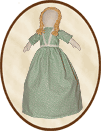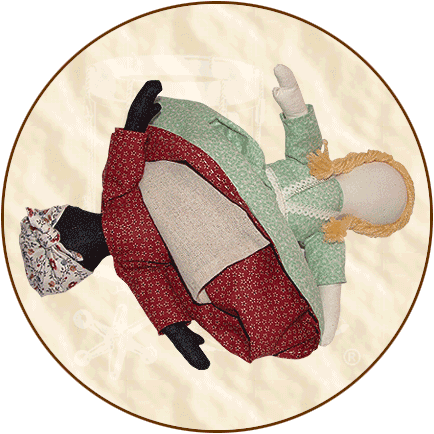.
Continued from product description on
Historical Doll Kits' Page Four...
Historical
Background: Considered a controversial doll by some, the
authentic Topsy-Turvy doll, features a black doll with a headscarf
on one end and a white doll with an antebellum-style dress on
the other end. The black doll could represent a maid, slave or
servant and the white doll could represent the master's child
or the mistress of the house.
The original Topsy-Turvy dolls were created before the Civil
War in the Southern United States on plantations where slavery
was prominent. Arguments arise as to whether the dolls were made
for the slave children to play with or whether they were made
for the white children who lived in the plantation house.
 With
one identity on one side and an opposite identity when flipped,
slave children could have played with their prohibited black
doll and then flipped it to the white doll when the master was
around. Others believe that the double-ended dolls were made
for white children with the black doll used as a maid for their
other dolls.
With
one identity on one side and an opposite identity when flipped,
slave children could have played with their prohibited black
doll and then flipped it to the white doll when the master was
around. Others believe that the double-ended dolls were made
for white children with the black doll used as a maid for their
other dolls.
Stephanie V. Siek writes that this doll "was a mirror
of the African-American woman's life. She took care of white
children, but had children of her own -- the white child is present
when the black child is invisible, the black child is present
when the white child is invisible."
Kimberly Wallace-Sanders has explored the possibility that
Topsy-Turvy dolls were made by the black mammies to represent
the two categories of children they took care of: the white master's
children verses their own. After the Civil War, the white side
of the doll was identified as that of a child, while the black
doll suggested the black mammy caretaker.
Black and White Topsy-Turvy dolls began to be mass manufactured
after 1900. One of these dolls made in 1901 was purchased with
the advertisement: "Turn me up and turn me back, first I'm
white, and then I'm black." The Babyland Rag company produced
a Topsy-Turvy doll with a hand painted face in 1901. Later, wooden
Topsy-Turvy dolls were made with jointed arms.
Regardless of its history, this is a very unique doll and
many storybook and nursery rhyme characters have been based on
it since its inception. These upside down dolls have been used
to teach the differences between the characters, showing contrasts
between two opposites, good or bad, rich or poor, average and
prominent, innocent and evil, subservient and authoritative.
 During
the mid 1900s, McCalls, Vogart, Redline and Butterick pattern
companies began producing their own Topsy-Turvy Doll patterns.
Vogart's pattern in the1940s was titled, "Topsy and Eva
Doll--One doll with two changeabout faces." Redline's pattern
in the 1940s was called Topsy and Eva. McCalls' 1940's pattern
#1014 was for an "Upside Down Doll," but both dolls
were white. Some of these historic patterns are now available
as copies.
During
the mid 1900s, McCalls, Vogart, Redline and Butterick pattern
companies began producing their own Topsy-Turvy Doll patterns.
Vogart's pattern in the1940s was titled, "Topsy and Eva
Doll--One doll with two changeabout faces." Redline's pattern
in the 1940s was called Topsy and Eva. McCalls' 1940's pattern
#1014 was for an "Upside Down Doll," but both dolls
were white. Some of these historic patterns are now available
as copies.
Some of the dolls that were made in the mountain regions of
North Carolina in the1970s featured one doll head on one side
and 2 to 3 doll heads on the other side, like Goldilocks and
the Three Bears (with three heads), or Little Red Riding Hood
on one side and Grandmother on the other side, but with the wolf
on the back side of grandmother. Even Hansel and Gretel appeared
with two heads (the children) on one side of the doll and the
evil witch on the other. Some of these dolls are featured in
a book titled, "How to Make Upside-Down Dolls" by John
Coyne and Jerry Miller, published in 1977, which features patterns
and instructions for ten upside-down dolls. The introduction
in this book mentions the Crafts Unlimited group and craft cooperatives
that the doll makers in the Appalachian area belonged to. Many
of their dolls were sold in New York City and Chicago. John Coyne
states, "This book is the first time any of these upside-down
dolls have been shown in a 'how-to' fashion."
We don't know if the original Topsy-Turvy dolls were used
in a teaching manner or whether they were just played with. Only
a very few of these flip-flop dolls remain from the early 1900s.
Several are located in museums and others are in private collections.
Valerie Borey who holds a B.A. in Cultural Anthropology from
the University of Minnesota and an M.A. in the Social Sciences
from the University of Chicago writes: "Although the Topsy-Turvy
doll had changed substantially in design since the pre-war years
in the American south, it retained its essential capacity to
emphasize the differences between the powerful and the powerless.
For this reason, it is a doll uniquely able to detect and reflect
cultural tensions as they changed with the times and economic
conditions. As if a looking glass into the American social order,
the two-headed, reversible, upside-down doll is able to turn
things, well, topsy-turvy. In this sense, it is more than a doll--it
is a symbol of power, of resistance, of secrecy, and of revolution."
Museums with Topsy-Turvy dolls included in their collection:
California African American Museum, Los Angeles, CA
Churchill County Museum, Fallon, NV
Mariposa Museum & World Culture Center, Peterborough, NH
New York Historical Society, New York, NY
Orange County Historical Museum, Hillsborough, NC
Philadelphia Doll Museum, Philadelphia, PA
Stoy Museum of the Lebanon County Historical Society, Lebanon,
PA













